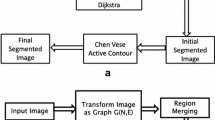Abstract
This paper introduces a new mesh segmentation approach into semantic parts, most closely resemble those made by humans, which is based on the pixel color of the images used in the 3D reconstruction. This approach allows to segment the mesh into semantic and a much simpler way than most of the mesh segmentation methods that are based on the geometrical characteristics of the mesh. The principle of our method is to establish a link between the color objects of the scene and the mesh while exploiting the link between the interest points of the images brought into play and the vertices of 3D mesh. The results in great part, reflect the efficiency and performance of our method.











Similar content being viewed by others
References
Attene M, Falcidieno B, Spagnuolo M (2006) Hierarchical mesh segmentation based on fitting primitives. Vis Comput 22(3):181–193
Bhatia SK (2004) Adaptive k-means clustering. In FLAIRS conference (pp. 695–699)
Cazals F, Giesen J (2006) Delaunay triangulation based surface reconstruction. In Effective computational geometry for curves and surfaces(pp. 231–276). Springer Berlin Heidelberg
Chen X, Golovinskiy A, Funkhouser T (2009) A benchmark for 3D mesh segmentation. In ACM Transactions on Graphics (TOG) (Vol. 28, No. 3, p. 73). ACM
Fischler MA, Bolles RC (1981) Random sample consensus: a paradigm for model fitting with applications to image analysis and automated cartography. Commun ACM 24(6):381–395
El Akkad N, Merras M, Saaidi A, Satori K (2014) Camera self-calibration with varying intrinsic parameters by an unknown three-dimensional scene. Vis Comput 30(5):519–530
Fu KS (Ed.) (2013) VLSI for pattern recognition and image processing (Vol. 13). Springer Science & Business Media
Furukawa Y, Ponce J (2010) Accurate, dense, and robust multiview stereopsis. IEEE Trans Pattern Anal Mach Intell 32(8):1362–1376
George D, Xie X, Tam GK (2017) 3D Mesh Segmentation via Multi-branch 1D Convolutional Neural Networks. arXiv preprint arXiv:1705.11050
Ghosh M, Amato NM, Lu Y, Lien JM (2013) Fast approximate convex decomposition using relative concavity. Computer-Aided Design
Goesele M, Snavely N, Curless B, Hoppe H, Seitz SM (2007). Multi-view stereo for community photo collections. In Computer Vision, 2007. ICCV 2007. IEEE 11th International Conference on (pp. 1–8). IEEE
Gold CM, Dakowicz M (2005) The crust and skeleton–applications in GIS. In Proceedings, 2nd. International Symposium on Voronoi Diagrams in Science and Engineering (pp. 33–42)
Golovinskiy A, Funkhouser T (2008) Randomized cuts for 3D mesh analysis. ACM transactions on graphics (TOG) 27(5):145
Golovinskiy A, Funkhouser T (2008). Randomized cuts for 3D mesh analysis. In ACM transactions on graphics (TOG) (Vol. 27, No. 5, p. 145). ACM
Jeon J, Jung Y, Kim H, Lee S (2016) Texture map generation for 3D reconstructed scenes. The Visual Computer, 1–11
Katz S, Tal A (2003) Hierarchical mesh decomposition using fuzzy clustering and cuts. ACM Trans. Graph. (SIGGRAPH) 22(3):954–961
Katz S, Leifman G, Tal A (2005) Mesh segmentation using feature point and core extraction. Vis Comput 21(8–10):649–658
Krayevoy V, Sheffer A (2006). Variational, meaningful shape decomposition. In ACM SIGGRAPH 2006 Sketches (p. 50). ACM
Lai P, Samson C (2016) Applications of mesh parameterization and deformation for unwrapping 3D images of rock tunnels. Tunn Undergr Space Technol 58:109–119
Lai YK, Hu SM, Martin RR, Rosin PL (2008). Fast mesh segmentation using random walks. In Proceedings of the 2008 ACM symposium on Solid and physical modeling (pp. 183–191). ACM
Lhuillier M, Quan L (2002) Match propagation for image-based modeling and rendering. IEEE Trans Pattern Anal Mach Intell 24(8):1140–1146
Lhuillier M, Quan L (2005) A quasi-dense approach to surface reconstruction from uncalibrated images. IEEE Trans Pattern Anal Mach Intell 27(3):418–433
Lien JM, Amato NM (2007) Approximate convex decomposition of polyhedra. In Proceedings of the 2007 ACM symposium on Solid and physical modeling (pp. 121–131). ACM
Lien JM, Amato NM (2008) Approximate convex decomposition of polyhedra and its applications. Computer Aided Geometric Design 25(7):503–522
Liu R, Zhang H, Busby J (2008). Convex hull covering of polygonal scenes for accurate collision detection in games. In Proceedings of graphics interface 2008 (pp. 203–210). Canadian Information Processing Society
Lowe DG (1999) Object recognition from local scale-invariant features. In Computer vision, 1999. The proceedings of the seventh IEEE international conference on (Vol. 2, pp. 1150–1157). Ieee
Pollefeys M, Koch R, Vergauwen M, Van Gool L (2000) Automated reconstruction of 3D scenes from sequences of images. ISPRS J Photogramm Remote Sens 55(4):251–267
Serino L, di Baja GS, Arcelli C (2010) Object decomposition via curvilinear skeleton partition. In 2010 International Conference on Pattern Recognition (pp. 4081–4084). IEEE
Shapira L, Shamir A, Cohen-Or D (2008) Consistent mesh partitioning and skeletonisation using the shape diameter function. Vis Comput 24(4):249–259
Shu Z, Qi C, Xin S, Hu C, Wang L, Zhang Y, Liu L (2016) Unsupervised 3D shape segmentation and co-segmentation via deep learning. Computer Aided Geometric Design 43:39–52
Ulusoy AO, Black MJ, Geiger A (2017) Semantic multi-view stereo: Jointly estimating objects and voxels. In Proc. IEEE Conf. on Computer Vision and Pattern Recognition (CVPR) (Vol. 2)
Wang H, Lu T, Au OKC, Tai CL (2014) Spectral 3D mesh segmentation with a novel single segmentation field. Graph Model 76(5):440–456
Xie Z, Xu K, Liu L, Xiong Y (2014) 3d shape segmentation and labeling via extreme learning machine. In Computer graphics forum (Vol. 33, No. 5, pp. 85–95)
Yao L, Huang S, Xu H, Li P (2015) Quadratic error metric mesh simplification algorithm based on discrete curvature. Math Probl Eng 2015:1–7
Zeramdini B, Robert C, Germain G, Pottier T (2016) Simulation of Metal Forming Processes with a 3D Adaptive Remeshing Procedure
Zöckler M, Stalling D, Hege HC (2000) Fast and intuitive generation of geometric shape transitions. Vis Comput 16(5):241–253
Author information
Authors and Affiliations
Corresponding author
Rights and permissions
About this article
Cite this article
Taime, A., Saaidi, A. & Satori, K. A new semantic segmentation approach of 3D mesh using the stereoscopic image colors. Multimed Tools Appl 77, 27143–27162 (2018). https://doi.org/10.1007/s11042-018-5911-y
Received:
Revised:
Accepted:
Published:
Issue Date:
DOI: https://doi.org/10.1007/s11042-018-5911-y




